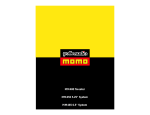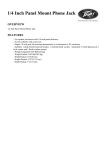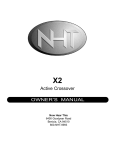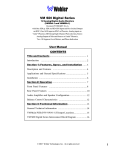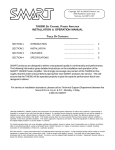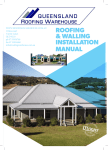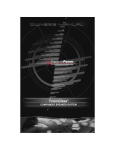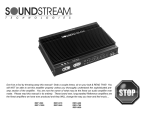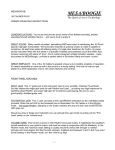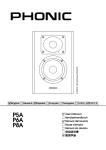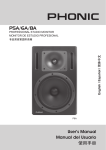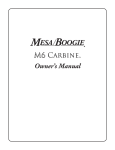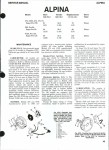Download Installation Manual For Rockford Fosgate Power 360 and Power 650
Transcript
INSTALLATION MANUAL FOR ROCKFORD FOSGATE POWER 360 360 AND POWER 650 POWER 650 Rockford Corporation 613 South Rockford Drive Tempe Arizona 85281 (602) 967-3565 INDEX Introduction . . . . . . . . . . . . . . . . . . . . . . . . . . . . . . . . . . . . . . . . . . . . . 1 Amplifier Features . . . . . . . . . . . . . . . . . . . . . . . . . . . . . . . . . . . . . . . 2 System Flexibility . . . . . . . . . . . . . . . . . . . . . . . . . . . . . . . . . . . . . . . . 3 Bridging . . . . . . . . . . . . . . . . . . . . . . . . . . . . . . . . . . . . . . . 4 Amplifier Block Diagram . . . . . . . . . . . . . . . . . . . . . . . . . . . . . . . . . 5 Why Biamplify? . . . . . . . . . . . . . . . . . . . . . . . . . . . . . . . . . . . . . . . . . 6 Speaker Impedance . . . . . . . . . . . . . . . . . . . . . . . . . . . . . . . . . . . . . 7 Wire . . . . . . . . . . . . . . . . . . . . . . . . . . . . . . . . . . . . . . . . . . . . 7 Power Ratings . . . . . . . . . . . . . . . . . . . . . . . . . . . . . . . . . . . . . . . . . . . 8 Piezoelectric Tweeters . . . . . . . . . . . . . . . . . . . . . . . . . . . . . . . . . . . 8 Crossover System . . . . . . . . . . . . . . . . . . . . . . . . . . . . . . . . . . . . . . . 9 Using the Crossovers . . . . . . . . . . . . . . . . . . . . . . . . . . . . . . . . . . . 10 Crossover Settings . . . . . . . . . . . . . . . . . . . . . . . . . . . . . . . . . . . . . 11 Crossover Response Curves . . . . . . . . . . . . . . . . . . . . . . . . . . . . 12 Amplifier Power Wiring . . . . . . . . . . . . . . . . . . . . . . . . . . . . . . . . . 13 DIN Interconnect Cable . . . . . . . . . . . . . . . . . . . . . . . . . . . . . . . . . 14 Input Mode Switch . . . . . . . . . . . . . . . . . . . . . . . . . . . . . . . . . . . . . 14 Turn-on Connection . . . . . . . . . . . . . . . . . . . . . . . . . . . . . . . . . . . . 15 Mounting the 360 . . . . . . . . . . . . . . . . . . . . . . . . . . . . . . . . . . . . . . . 15 Power 650 Specifications . . . . . . . . . . . . . . . . . . . . . . . . . . . . . . . 17 Power 360 Specifications . . . . . . . . . . . . . . . . . . . . . . . . . . . . . . . 18 Biamplified Mode Wiring Diagram . . . . . . . . . . . . . . . . . . . . . . . 19 Power 19 Amplifier Speaker 6501360 Stereo Biamplified Mode Wiring Diagram . Biamplified Stereo Diagram . . . . . . . . . . . . . . . . . . . . . . . . . . . . . 20 Biamplified Stereo Bridged Mono Woofer Diagram . . . . . . . 21 Dual Stereo Diagram . . . . . . . . . . . . . . . . . . . . . . . . . . . . . . . . . . . 22 Bridged Stereo Diagram . . . . . . . . . . . . . . . . . . . . . . . . . . . . . . . . 23 Bridged Mono Biamplified Diagram . . . . . . . . . . . . . . . . . . . . . . 24 INTRODUCTION The Power 650 and Power 360 are state-of-the-art 4 channel power amplifiers for cars, vans, or wherever a 12-volt battery is available. The amplifiers are designed to be used with a Rockford-Fosgate equalizer/pre-amplifier and any high-quality radio, tape, or other music source. There are several equalizer/pre-amplifier units available, including the ZX, and Z, and the 250 preamp. The Power 650 will provide 325 watts per channel (stereo) and incorporates a variable-speed fan and shroud assembly for cooling. The Power 360 provides 180 watts per channel (stereo) and is cooled by a finned heatsink. Both the Power 650 and Power 360 offer exceptional flexibility in system design. With switchable crossovers and four bridgeable power amplifier channels, biamplified systems, high-powered bridged systems, combinations, and four-channel systems are easy to put together. Both amplifiers are stable into 2-ohm loads, or 4-ohm loads when bridged. Protection circuitry in the amplifiers prevent damage due to shorts, system power problems, or internal failures. They incorporate internal battery line filtering and extensive noise prevention circuitry. The Power 650 and Power 360 are designed to be professionally installed. The length and nature of your warranty are dramatically affected if you attempt to install it yourself (See Warranty). This is because professional installers are experienced with making your car sound right the first time. Professional installers make their installations durable because they don’t want continuing problems and complaints - their reputations are valuable. If you want to install your own unit, read this booklet completely - and Good Luck! -l- AMPLIFIER FEATURES The Power 650 and Power 360 are have selectable crossovers, four protection, independently available rejection circuitry. System wiring identical. very similar in design. Both bridgeable channels, load bass channels, and noise for the two amplifiers is The Power 650’s variable-speed fan-cooling assembly allows it to run at higher power and into lower-impedance loads than the Power 360. With four 4-ohm loads, each channel of the Power 650 puts out 125 watts, while the 360 puts out 90. The Power 650 is rated for four 2-ohm loads, at 160 watts each or two 4-ohm loads in bridged stereo at 325 watts each. The Power 360 is not rated for 2-ohm loads, and the bridged output is two 8-ohm loads at 180 watts each. -2- SYSTEM FLEXIBILITY A combination of switched crossovers and four bridgeable channels in the Power 650 and Power 360 provide unmatched system flexibility with simple wiring changes. Some of the possibilities are: Biamplified Stereo - A pair of channels drives mid and high frequency speakers; another pair drives woofers. The crossovers are set to separate the input frequencies into high and low frequencies for each speaker system. Biamplified Stereo with Bridged Mono Woofer - Otherwise similar to the Biamplified stereo system above, this arrangement bridges the two low channels into a single woofer. Bridged Stereo - Each pair of channels on Left and Right sides is bridged into a full-range speaker system. The crossovers are set at Flat position. Bridged Mono Biamplified -This configuration produces watts into one mono channel. The high-frequency channel pair is bridged into midtweeter speaker system and the lowfrequency pair bridged into a woofer. The crossovers are set to separate woofer and midrange frequencies. Dual Stereo - With the crossovers set at “Flat” position, the power amp will act as two separate stereo amplifiers, one channel pair for rear full range speakers, one for front fullrange 4-ohm speakers. If only one set of speakers can handle bass frequencies, the “High” crossover can be set to cut off the front speakers’ low frequency drive. All of these system configurations are obtained with simple wiring variations; there are no special “black boxes” to buy and the system may be modified at any time. -3- AMPLIFIER BRIDGING Operating an amplifier in the “bridged” or “strapped mono” mode means driving one speaker or speaker system with two amplifier channels. Each channel will put out full power into its half of the speaker load, so the system can drive the speaker with double the power that a single amplifier channel would be capable of. When amplifiers are bridged into a single speaker, amplifier “sees” half of the total speaker impedance. each New Rockford-Fosgate amplifiers are designed so that connecting the amplifier for bridged mode is a simple matter of using the correct speaker leads as shown in the appropriate system diagram. In these amplifiers, one channel of each pair is inverted in the amplifier. In normal stereo use, the inverted channel output is connected to the negative lead of its speaker load, thus preserving the system’s polarity. In bridged mode, the inverted channel is connected to the negative lead of the speaker to be bridged, and the positive lead of the speaker is connected to the non-inverted channel. This provides the outof-phase drives required for bridged operation. The Power 650 and Power 360 are designed so that the four amplifier sections can be bridged in several ways. Right and Left High-Frequency channels can be bridged, the Right High and Left Low-Frequency channels can be bridged, the Right High and Right Low channels can be bridged together, and the Left High and Left Low channels can be bridged. These combinations allow an unmatched flexibility in designing stereo, biamplified, and hybrid bridged systems. The Amplifier Block Diagram shows a simplified diagram of crossover and amplifier system. In the amplifier blocks, input shows a “+” for the non-inverted channels and a “-” for inverted channels. Each “+” channel can be mated to a channel into a bridged speaker load. -4- the the the “-” DIN COllfl INPUTS RCA Conn POWER 650/360 AMPLIFIER BLOCK DIAGRAM -5- WHY BIAMPLIFY? For the performance. Biamplified systems can play cleanly at higher output levels than stereo systems of the same total power. For the convenience. Building a satisfactory crossover system for woofer-to-midrange crossover frequencies requires large, expensive inductors and capacitors, as well as design time and mounting problems. With a biamplified system it’s all done for you in the active crossover. Biamplified systems consist of an active (electronic) crossover system and two stereo amplifiers. The crossover separates the input signal into low and high-frequency groups and sends each group of frequencies to a separate amplifier pair. In most installations, the low-frequency amplifiers drive a pair of woofers and the high-frequency amplifiers drive a midrangetweeter pair. In ordinary stereo systems, as the output level increases, the low-frequency, high-power notes of the music start to drive the amplifier into clipping. When the bass (drums, rhythm, etc.) start to overload the amplifier, all higher frequencies are naturally clipped as well, so midrange distortion is immediately audible. The harshness and “gargling” effects of clipping are obnoxious to listen to and may destroy tweeters. In a well-designed biamplified system, when the low frequencies start to clip only the low-frequency amplifiers overload. The high-frequency amplifiers are still reproducing the music cleanly. Harshness and other overload effects are not heard in the middle and high frequencies until the high-frequency amplifiers clip, at a much higher level. The worst effects of the bass amplifiers’ clipping will usually not be audible, since the woofers won’t reproduce the high-frequency harmonics of the clipped drive, and the clean middle and high frequencies cover the low-frequency blurring and muddiness of the bass. We have found that, for crossover frequencies up to about 600 Hertz, it is best to use approximately equal power for the low and high frequency amplifiers of biamplified systems. If the highfrequency amplifiers are significantly lower in power, the highs will clip before bass distortion is audible, and much of the bass power capability will be wasted. -6- Triamplifying; that is, using another active crossover and stereo amplifier to run the tweeters only, is technically interesting but less cost-effective. For one thing, there is little or no masking effect from the very high frequencies for midrange distortion, so the biggest performance advantage of multiple-amp systems isn’t available. Crossover components for passive midrange-totweeter crossovers are reasonably small and inexpensive. Running a separate tweeter amp system will prevent tweeter burnout due to heavy midrange clipping, and this is the most substantial advantage of triamplified systems. SPEAKER IMPEDANCE The Power 650 is designed for a 2-ohm nominal minimum impedance on each of its four channels. (Two 4-ohm speakers in parallel form a 2-ohm load.) The Power 360 is designed for a 4-ohm nominal minimum impedance on each of its four channels. In bridged mode (two amplifier channels driving a single load), each channel “sees” half of the load impedance. Therefore the Power 650’s minimum load impedance in bridged mode is 4ohms, and the Power 360’s minimum is 8-ohms. If an output wire from the impedance drops below safe into short protection mode. In off for several seconds every amplifier shorts, or if the load minimums, the amplifier will go “shortstop” the amplifier will turn time it senses an overload. SPEAKER WIRE We recommend that you always use substantial wire for speaker wiring harnesses. For short runs, 18-Gauge 18-Gaugewirewire is the smallest we suggest; for runs over 6 feet, at least 16-Gauge 16-Gauge should be used. Never allow any speaker wire to touch chassis ground. Many users find that sound quality is improved by the use of speciallymade heavy-duty speaker wiring from one of several manufacturers. The Power 650 and 360 output harnesses use short runs of 16-Gauge wire and should not reduce any benefits gained from specialized speaker wiring. -7- SPEAKER POWER RATINGS The Power 650 and 360 are very high-powered amplifiers, and special care must be taken to be sure that the speakers can handle the power levels. The speaker manufacturer’s recommendations for power levels and crossover frequencies should be observed. Woofers with high power ratings sometimes “pop”, “clang”, “snap”, or otherwise show signs of bottoming. These speakers are designed to use the “air spring” of an enclosed box to prevent bottoming at high power inputs. This applies to most woofers originally designed for home or professional use. One solution is to use speakers designed for “infinite baffle” use, which have very stiff suspensions. The best solution is to build boxes for the woofers. As with woofers, midrange drivers’ power capabilities are determined by voice coil and suspension design. The most common power-handling problems for mid-ranges arise when they are crossed over at too low a frequency or with too shallow a crossover slope. For every doubling of the crossover frequency, a given midrange driver will handle 20-150% more system power. The same improvement would result from going from a 6dB/Octave to a 12dB/Octave crossover. Tweeters will react the same as midranges to changes in frequency and slope of their crossovers: the higher the frequency and the greater the slope, the more power the tweeter will handle. Tweeter types that are usually above average in power handling ability include ferrofluid-cooled domes ¾ inches in diameter or larger. PIEZOELECTRIC TWEETERS Piezoelectric tweeters (“piezos”) offer ruggedness, efficiency, and extended frequency capability. They also often have a “rough” or “harsh” sound due to large response irregularities and distortion. They are usually a difficult load for an amplifier. One characteristic of piezos is that they are a nearly pure capacitive load. This means that their impedance continuously decreases with increasing frequency. Unless some means is used to prevent this continuous decrease, a typical piezo tweeter’s impedance falls to well under 1 ohm within the bandwidth of the amplifier. This low capacitive impedance can upset the amplifier’s compensation scheme and cause ultrasonic (inaudible) oscillations, overheating or damaging the amplifier. A simple method of preventing problems is to be sure there is at least 6 feet of speaker lead between the amplifier and the piezo. All amplifiers are tested with piezo loads and 6 feet of lead, and they will have no problem. Another method of taming the piezo is to insert a 1- to 10-ohm resistor in series with one of its leads. CROSSOVER SYSTEM The Power 650 and Power 360 incorporate separate high- and low-frequency crossovers, which are controlled by screwdriverslot switches on one end of the power amplifier. The crossover frequency is set to one of five frequencies or to flat response, depending on speaker and system characteristics. The crossover is a two-pole (12 dB/Octave) constant-power design with a Butterworth transfer characteristic. Outputs are designed for an accurate phase match between low- and highfrequency outputs (within 5 degrees) to eliminate cancellation and lobing errors. High Frequency Crossover Position Frequency 1 Flat 100 Hz 2 3 250 Hz 4 600 Hz 1500 Hz 5 6 4000 Hz Low Frequency Crossover Position Frequency 1 Flat 2 100 Hz 3 250 Hz 4 600 Hz 5 1500 Hz 6 4000 Hz -9- USING THE CROSSOVERS The crossovers are usually used in biamplified mode. They separate the frequencies in the input signal into low and high frequencies for the separate woofer and high frequency amplifiers. (See the Amplifier Block Diagram for a system layout.) When the crossovers are used for biamplified systems, the High and Low frequencies are usually set equal. The most common crossover frequency for biamplified systems is 250 Hertz. This frequency setting keeps the worst of the lowfrequency power out of the midranges but doesn’t require the woofers to do a great deal of midrange. For systems whose midrange speakers cannot handle a lot of power, a 600 Hertz crossover setting will save the drivers. For systems with essentially full-range front speakers or very rugged and large midranges, a 100 Hertz crossover frequency gives better imaging by putting more midrange energy up front with the tweeters. The main use of the 4000 and 15000 Hertz crossover frequencies is for complex systems which use the amplifier as a midrangetweeter biamplified system. 4000 Hertz is a satisfactory crossover point for most midrange-tweeter combinations. 1500 Hertz might be used with an extremely rugged tweeter or a small midrange. The crossover system can be used to do a certain amount of equalization for correcting response problems in the car. If the crossover frequencies in a biamplified system are “underlapped”; that is, the low-frequency crossover is set one notch lower than the high-frequency crossover, a 6dB dip appears in the overall “summed” system response. Its frequency is centered between the low and high crossover settings. If the crossovers are “overlapped”, the response shows a gradual peak of about 2 dB, again centered between thecrossover settings. The “dip” response in particular can improve cars which have a bad midrange bulge at around 150-200 Hertz, as often happens. Setting the low crossover at 100 Hertz and the high crossover at 250 Hertz produces a 6 dB dip at 160 Hertz, removing tubbiness and unnatural male voices produced by the car’s resonance. See “Crossover Response Curves” for a graph. CROSSOVER SETTINGS Crossover Setting, Hz (Low/High) Suggested Applications Flat/Flat Dual Stereo systems with two pairs of full range speaker systems. All Bridged Stereo systems. Flat/l 00 Dual Stereo systems with front speakers having less bass capability. Flat/250 Dual 100/1 00 “Subwoofer” biamplified systems. Large woofers on low channel, essentially full-range system on high channel (usually a strong midrange-tweeter pair). Excellent imaging. 250/250 “Three-way” biamp systems. W o o f e r s o n l o w channel, midranges and tweeters on high channel. Good imaging. 100/250 “Subwoofer” and three-way systems in cars which have a lower-midrange resonance. Combines imaging advantages of subwoofer with reduced midrange power requirements. Excellent imaging. 600/600 “Three-way” biamp systems. As above in 250/250 section, but midrange drivers handle less power. Fair imaging. 1500/1500 “Three-way” biamp systems having a very light duty midrange. “ T w o - w a y ” biamp systems with widerange woofers on the low channel and extremely rugged tweeters on the high channel. 4000/4000 Primarily a midrange-to-tweeter triamplified systems. Stereo systems -ll- with small front speakers. crossover point for Summed Output Power--Flat 0 Output dB -3 -6 -9 -12 -15 63 250 160 400 600 950 Frequency, Hertz BOTH CROSSOVERS SET EOUAL (250 Hertz) Outpu dB 100 63 160 250 Frequency, 400 600 950 Hertz CROSSOVERS OVERLAPPED (Low 100 Hertz, High 250 Hertz) Summed Output Power--2 dB Peak +3 -0, e-- _#-- L_------ - - _ 160 _ ---_ 250 Frequency, 400 600 950 Hertz CROSSOVERS OVERLAPPED (Low 250 Hertz, High 100 Hertz) CROSSOVER RESPONSE CURVES -12- AMPLIFIER POWER WIRING The Power 650 and Power 360 battery power connections are made with heavy self-resetting wire. A circuit breaker and connectors are provided with the unit. For best performance wire the amplifier exactly as described. Any resistive connections or voltage drops in the power wiring will result in significant power output losses. White Power Wire - This wire goes directly to the circuit White Power Wire breaker mounted near the battery. It is best to use as short a wire run as feasible: spare crimp connectors for shortened wires are provided with the unit. Don’t run the power wire near the interconnect cabling for the preamp: it will induce noise. Circuit Breaker Battery Power Wire Wire - The circuit breaker Breakerand and Battery Power should be mounted in the car engine compartment near the battery. Connect the “BAT.” terminal of the breaker to the Positive (+) terminal of the battery using the 1-foot length of heavy wire provided. Connect the other terminal to the white power-wire leading to the power amplifier. Black Ground Wire Black Ground Wire - Connect this wire directly to a good chassis ground point. Clean off paint and corrosion around the ground point to ensure a good connection and bolt the wire securely to the metal. Be sure that the ground point you have selected is a piece of chassis metal that is welded to the main body of the car. (Bare metal should be protected with a layer of grease or paint to prevent rusting.) DO NOT extend the ground lead over one foot longer than supplied, since any voltages developed in the ground lead can appear as hard-tosuppress system noise problems. Remember that the Power 650 can have peak current demands well over 100 Amperes. Make any splices secure, never use less than 10-Gauge wire, and never use longer wire runs than necessary. -13- DIN INTERCONNECT CABLE The 5-pin DIN cable provided connect the Amp to its equalizer/ preamplifier. Run this cable away from the main power wire (white 10-Gauge) to prevent noise from being coupled into the cable. Cable color code and pin configuration are given below: Shield - Ground - +18 Volts Red Black - -18 Volts White - Right Channel Signal+ Green - Left Channel Signal + (or yellow) Ground- Power Amplifier Female or pre-out Connector INPUT MODE SWITCH The input of the Power 650 and Power 360 normally comes from the DIN input connector and is split by the crossovers into high and low channel drives. However, there are some cases where it is desirable to be able to drive the low channels independently. For instance, if one wanted to drive the system as two completely independent stereo amplifiers, one would need to drive the high channel pair with one stereo signal pair, and the low channel with another. The input mode switch (located near the crossover controls on the units front panel) switches the low channel inputs over the RCA female connectors. The low-frequency crossover remains in the circuit and can be used as usual. -14- TURN-ON CONNECTION (Red Wire from 9-Pin Connector) The Power Amplifier is turned on by applying Positive 12 Volts to the red wire. Usually, the red wire is connected to source unit’s “Accessory” or “Auto-Antenna” lead, either of which will go positive when the source is turned on. Although the majority of high-quality automotive source units have an Accessory or Auto-Antenna output, there are many variations which may require different turn-on methods. If the source has no Auto-Antenna lead (or if Auto-Antenna goes down during tape operation): a. Find the internal switched power voltage inside the source unit and solder a lead to it. Run the lead out through the back of the unit (being sure to use a grommet for insulation from the case) and connect to the amplifier’s red turn-on b. Or: Install a switch in the car with one terminal connected to +12 Volts and the other to the amplifier’s red lead. c. Or: Connect the amplifier’s red lead to the Accessory point at the car’s fuse block. In this case the amplifier will be on whenever the car is on. This method will allow the amplifier to amplify any noise and turn-on and turn-off transients, and may therefore be unsatisfactory. MOUNTING THE POWER 650 Since the Power 650 has forced-air cooling rather than relying on convection, it can be mounted anywhere and in any position it will fit. The only requirement is that the fan intake and exhaust are not blocked from fresh air. MOUNTING THE POWER 360 The mounting position of the Power 360 will have a large effect on its ability to dissipate the heat generated in normal operation. The Power 360 has an ample heat sink for its dissipation, and internal overheating shutoff circuitry, so it is reasonably tolerant of mounting variations. However, care should be taken to be sure of adequate cooling. -15- Trunk Mounting - We have measured trunk temperatures as high as 150 degrees Farenheit in the summertime. Since the thermal shutoff point for the Power 360 is 195 degrees F, it is easy to see that the amp must be mounted for maximum cooling capability. Mounting the unit on the floor or top of the trunk will not allow convection air flow across the fins. Even better is to mount the unit vertically on a vertical surface, so upward-flowing air follows thechannels between the heatsink fins. The Power 360 is too tall for this to usually be practical, however. Passenger Compartment Mounting - When the amp is mounted in the passenger compartment, mounting requirements are considerably relaxed, since the driver will not often allow temperatures to stay anywhere near 150 degrees F. Floor mounting is usually satisfactory in the cab, and under the seat will work as long as there is at least 1 inch above the amplifier fins for air movement. Vertical mounting (for instance, the back of pickup cabs) is still the best. Any situation which allows moving air to be directed over the cooling fins will improve cooling dramatically. A simple fan playing on the amplifier will improve cooling by a factor of 3. There are situations where it is feasible to direct some of the car’s refrigeration air over the amplifier. In any case it is critical that the amp not be enclosed in a box or covered so that air can’t flow. -16- POWER 650 SPECIFICATIONS Power Ratings: 4 Channel 4 Ohms: 125 watts per channel Ohms, 4 channels driven, less than 0.05% THD + & Noise). 2 Ohms: 160 watts per channel Ohms, 4 channels driven, less than 0.1% THD + N. continuous power into 4 from 20 to 20,000Hz, with N (Total Harmonic Distortion continuous power into 2 from 20 to 20,000Hz, with Power Ratings: 2 Channel (bridged) 4 Ohms: 325 watts per channel continuous power into 4 Ohms, 2 channels driven, from 20 to 20,000Hz, with less than 0.05% THD + N. ± .5dB. Frequency Response: 20 to 20,000Hz, Bandwidth: 15 to 20,000Hz, ± 3dB. Damping Factor: greater than 200 at 50Hz. Slew Factor: greater than 2.5. Slew Rate: greater than 10 volts per microsecond. Crossovers: slope is 12dB per octave. adjustable positions are: flat, 100Hz, 250Hz, 4KHz. 600Hz, 1.5Hz, and Protection The Punch possesses the ability to sense shorts in installation wiring and will not allow the amplifier to be damaged. The Punch also employs thermal switches which protect the amplifier from overheating damage. Fuses are provided for speakers which are directly connected with no crossover components. Dimensions 18 3/1 0” long x 8 1/10” wide x 2% high, exclusive of knobs and wiring. 19 3/10” long x 8 1/10” wide x 2%” high, minimum mounting requirements. Note: Achieving ultimate performance from Rockford Fosgate products is our main concern. Therefore research and development of a new product doesn’t end when it finally reaches production. For this reason Rockford’s specifications are subject to change without notice. - 17 - POWER 360 SPECIFICATIONS Power: Four channels at 90 Watts/Channel continuous, all channels driven into 4 Ohms, 20Hz - 20KHz, with less than .03% THD + Noise. Noise: Less than -8OdB both power amp and preamp. Crossover: 12dB/Octave, switch controlled. Crossover Frequencies: Flat 1 OOHz 250Hz 600Hz 1500Hz 4000Hz Preamp Sensitivity: 50Mv to 2.5V adjustable. Preamp Frequency Response: 20-Hz-20KHz + .dB. -18- POSITIVE-VOLTAGE TURN-ON TO SOURCE ACCESSORY OR AUTO-ANTENNA LEAD RED LEFT HIGH CHAN. MID-TWEETER INTERCONNECT CABLE TO EQUALIZER/ PREAMPLIFIER RIGHT HIGH CHAN. MID-TWEETER % u 5-PIN DIN CONNECTOR I 1 9-PIN CONNECTOR LEFT LOW CHAN. J WOOFER RIGHT LOW CHAN. POWER AMP WOOFER BLACK 8 -GAUGE / TO CHASSIS GROUND WHITE 8 -GAUGE-TO CIRCUIT BATTERY BREAKER POWER 650/360 STEREO BIAMPLIFIED MODE HIGH AND LOW CROSSOVERS SET TO SAME FREQUENCY -19- Midrange/ Tweeters Woofers Left High Channe l Left Low Channel Right Low Channel P o w e r 650 I P o w e r 360 9-Pin Connector Notes : High and Low crossovers set to 100, 250, or 600 Hertz BIAMPLIFIED - 20 - STEREO Right High Channel o Midrange/ Tweeters l 0 Left High Channe 1 Low Channe 1 Low Channel Right High Channel Power 650 / Power 360 9-Pin Connector Notes : Both High and Low Crossovers set to 100, 250, or 600 Hertz BIAMPLIFIED STEREO BRIDGED MONO WOOFER 2 1 I Full-Range Or Midrange/ Tweeters Left High Channel Left Low Channel Right Low Channel Right High Channel Power 650/ Power 360 9-Pin C o n n e c t o r Notes: Low c r o s s o v e r s e t t o “Flat”. H i g h c r o s s o v e r s e t t o “ F l a t ” f o r full-range f r o n t s p e a k e r 1 0 0 o r 2 5 0 Hertz f o r Midrange/Tweeter f r o n t s y s t e m . Note t h a t low c h a n n e l c o l o r c o d e s a r e r e v e r s e d biamplified systems. from DUAL STEREO w/Bridged Woofers -22- svstem. those o f Full-Range Left Right Channel Channel Power 650 / Power 360 9-Pin Connector Notes : Both High and Lou Crossovers set to “Flat” position. BRIDGED STEREO - 23 - -4 O Midrange/ Tweeters Woofers c - al 2 I High High Channel Channel I c’ L Power 650 / Power 360 #1 9-Pin Connector Low Channel i Channel Power 650 / Power 360 I #2 9-Pin Connector I Notes : High and lou crossovers set to 100, 250 or 600 Hertz. Bridging “Y” Adapter, P/N FA-683, Right channels See “Schematic, wiring to separate Bridged is used to amplifiers. Kono Biamplified split out Left and Mode” for complete system diagram. BRIDGED MONO BIAMPLIFIED -24 -


























